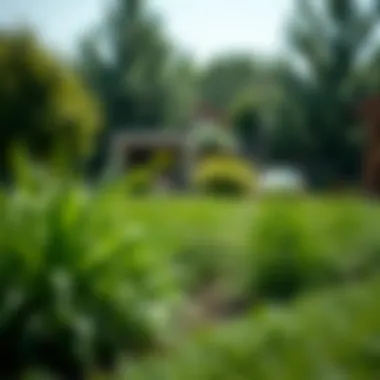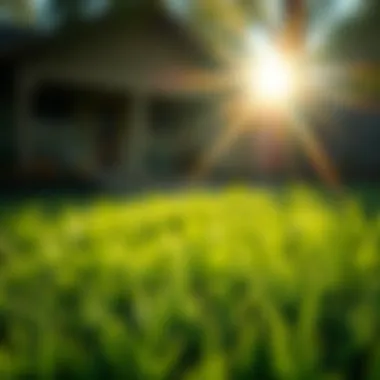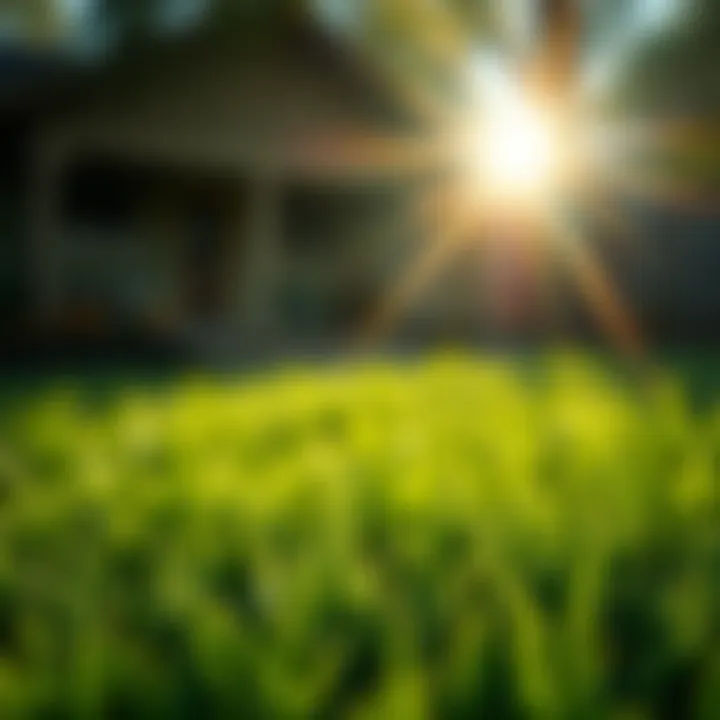Choosing the Best Sun Turf Grass for Your Landscape


Intro
Exploring sun turf grass can be an enlightening experience for homeowners and gardening enthusiasts alike. Sun turf grass varieties carry specific traits that can significantly influence the look and feel of outdoor spaces. In the sun-drenched areas of your yard, the right grass not only enhances the aesthetics but also works seamlessly with the local environment.
This guide is designed to immerse readers in the world of sun turf grass, shedding light on various options and care methods suited for sunny landscapes.
The sections that follow will outline the fundamental characteristics of diverse turf grass types, delve into maintenance routines essential for their health, and provide design inspirations to help cultivate vibrant gardens. Whether you're a seasoned gardener or just dipping your toes into the world of landscaping, you'll find valuable insights that can help you transform your exterior spaces into stunning showcases.
Here are some key points to consider:
- Characteristics of different sun turf grass varieties
- Benefits of choosing the right grass for sunny landscapes
- Ideal conditions for growth and maintenance practices
- Design inspirations to uplift your garden's appeal
- Seasonal tips to keep your turf healthy and thriving
By the end of this article, readers should feel empowered to make informed choices about sun turf grass that align with their landscape dreams.
Preface to Sun Turf Grass
When investing time and resources into your outdoor space, understanding the role of sun turf grass is paramount. This section introduces the significance of turf grass, particularly in sunny environments, and sets the stage for the ensuing detailed exploration of various types and their unique benefits.
Defining Sun Turf Grass
Sun turf grass refers to varieties of grass that thrive under direct sunlight, making them ideal for areas that receive ample sunshine throughout the day. Varieties such as Bermudagrass, Zoysiagrass, and several fescue types demonstrate various attributes that cater to diverse landscaping needs. Generally, these grasses exhibit resilience, allowing for a lush, green landscape that can endure heat and heavy foot traffic. Understanding how sun turf grass is defined helps homeowners make informed decisions about which type suits their specific needs.
One might think of sun turf grass as the backbone of a vibrant garden. The right choice of grass not only enhances the aesthetic appeal of your property but also contributes to the overall health of your outdoor environment. By picking the appropriate grass for sunny conditions, you can ensure that your landscape remains robust and inviting throughout the seasons.
Importance of Turf Grass in Landscaping
The role of turf grass in landscaping cannot be overstated. Beyond providing a green expanse that is visually appealing, turf grass offers a number of functional benefits:
- Erosion Control: It helps hold soil in place, thereby reducing erosion, especially on slopes or areas prone to water runoff.
- Habitat Creation: It provides a habitat for various beneficial insects and wildlife, contributing to local biodiversity.
- Heat Reduction: The natural cooling effect of a lush lawn can reduce ambient temperatures, creating more comfortable outdoor environments.
- Aesthetic Appeal: A well-maintained turf creates a beautiful backdrop for gardens, patios, and outdoor activities, boosting overall curb appeal.
Incorporating sun turf grass in your landscaping not only fulfills aesthetic desires but also fosters a healthy ecosystem. Homeowners who consider these factors will find that their choices lead to more sustainable and enjoyable outdoor spaces.
If you want a garden that makes a lasting impression, begin with the right turf grass. It’s more than just grass; it’s a foundation for your entire landscape.
By recognizing the integral role of turf grass in landscaping, you can appreciate why selecting the right sun turf grass for your region is critical. The benefits reach far beyond simple visuals, establishing a thriving environment that can elevate the value of your property.
Different Types of Sun Turf Grass
When we talk about sun turf grass, we open the door to a world where your yard can flourish. Choosing the right type of turf is more than just aesthetics; it directly impacts your garden's health and sustainability. Different types of sun turf grass bring distinct attributes that cater to various soil types, climates, and maintenance levels. This section aims to present three primary types of sun turf grass: Bermudagrass, Zoysiagrass, and the diverse Fescue varieties. Each has its perks and potential drawbacks to consider based on your unique landscape needs.
Bermudagrass: A Popular Choice
Bermudagrass is often seen as the MVP when it comes to sunny landscapes. Its widespread popularity stems from its hardy nature. This grass thrives in warm climates, making it a go-to option for homeowners in southern regions of the United States. The vibrant green hue and fine texture of Bermudagrass can give your yard that luscious golf course vibe.
- Sun Tolerance: This grass thrives in full sun, meaning if your yard basks in sunlight all day, Bermudagrass is a fit.
- Drought Resistance: Once established, it can handle some dry spells, reducing the stress of watering.
- Quick Recovery: This turf has a knack for bouncing back from foot traffic, making it perfect for areas with high activity like play spaces or patios.
That said, it does require regular mowing and fertilization. If you don't mind some maintenance effort, this grass can reward you with a stunning green space.
Zoysiagrass: Resilient and Thick
If you're after a thick, carpet-like lawn that stands up to the wear and tear of daily life, Zoysiagrass might be your best bet. Native to Asia, this grass variety has made its way to many gardens across the U.S. and has become a favored choice.
- Tolerance to Heat and Cold: One of Zoysiagrass's standout features is its ability to withstand both high temperatures and colder winters, making it suitable for various regions.
- Low Maintenance: While it has a slower establishment period compared to others, once it's growing, it requires less frequent mowing and less watering.
- Weed Resistance: Zoysiagrass forms a thick mat that helps choke out weeds, cutting down on herbicide usage.
However, it does take some time to establish. Patience is key if you want to see its lush growth unfold.


Fescue Varieties: Versatile and Adaptable
Fescue varieties might not be the first thing that comes to mind, but they merit some attention. They offer versatility, adapting to various growing conditions, which makes them a popular choice among homeowners in transitional climates.
- Tall Fescue: Known for its deep root system, it handles drought well. It's robust and suitable for high-traffic areas, too.
- Fine Fescue: This includes creeping red, chewings, and hard fescue types. They work well in shaded areas and provide a soft touch to lawns.
- Blending Options: Mix different fescue types for a lawn that thrives both in sun and shade, giving your yard a uniform look all season long.
Fescues might be a bit more dependent on moisture, but their adaptability makes them a desirable option for a variety of landscapes.
Combining these types of sun turf grass in your lawn can bring a unique touch to your outdoor space, balancing beauty with function.
Choosing the Right Sun Turf Grass for Your Region
Selecting the appropriate sun turf grass for your specific region is crucial for achieving a lush and sustainable landscape. Each variety of turf grass has distinct characteristics that make it better suited for certain environmental conditions. Factors like climate, soil type, and sun exposure are vital to consider, as they directly affect not only the health and growth of the grass but also its appearance and functionality in your garden.
One of the key benefits of choosing the right grass is the reduction of resources required for maintenance and upkeep. When you plant a grass species that naturally thrives in your local conditions, you’ll find that it’s more resilient against pests and diseases. This way, you minimize the need for chemical treatments and heavy irrigation, making it an environmentally friendly choice.
Additionally, understanding regional nuances ensures that your turf remains green and vibrant throughout the growing season, enhancing your outdoor space’s aesthetic. So, let’s explore the specific factors you need to contemplate when choosing your sun turf grass.
Climate Considerations
Climate plays a pivotal role in determining which sun turf grass will flourish in your area. Different grasses have varying tolerances to heat, cold, and moisture.
- Temperature: Warm-season grasses such as Bermudagrass thrive in regions where temperatures soar during the summer months. Conversely, cool-season varieties like Tall Fescue prefer environments where spring and fall are milder, and summers aren’t too extreme.
- Rainfall: Areas with significant rainfall might benefit from grasses that can handle wet conditions, while arid regions need drought-resistant options for survival.
- Frost Dates: Knowing your local frost dates helps in planning your planting. For instance, if you live in a place with a long frost period, it might be unwise to choose a grass that can't handle cold weather.
Considering these aspects will help you select turf grass that can withstand your environment, ensuring it grows with minimal intervention and offers the best results year-round.
Soil Type Evaluation
The type of soil in your garden is another factor that can either hamper or foster the growth of your selected turf grass. Different grasses have unique preferences for soil characteristics such as texture, pH, and nutrient content.
Here’s what to think about:
- Soil Texture: Sandy soils drain quickly but may not hold nutrients well, making them suitable for grasses like Zoysiagrass, which can tolerate this texture. Clay soils, while rich in nutrients, can hold too much water, which might lead to root rot for certain grass types.
- pH Levels: Most grasses prefer a pH between 6.0 and 7.0. Conducting a soil test can inform you about how to amend your soil if necessary. Some grasses thrive in slightly acidic soil, while others do better in alkaline conditions.
- Nutrient Content: Testing for essential nutrients can help determine whether your soil requires fertilizer or amendments. Grasses like Kentucky Bluegrass are nutrient-hungry, so ensuring your soil is up to par is essential for this variety.
Understanding your soil type aids in cultivating a thriving grass environment. When you tailor your grass choices to fit your soil conditions, you’re setting yourself up for success.
Sun Exposure Assessment
Lastly, the amount of sunlight your lawn gets is crucial in deciding which type of turf grass will thrive. Not all grasses have the same sun requirements.
- Full Sun: Most sun-loving grasses, such as Bermudagrass and Zoysiagrass, require a minimum of 6 to 8 hours of sunlight each day. If your lawn is situated where it basks in ample sunshine, these varieties will likely perform well.
- Partial Shade: Some areas may only receive filtered sunlight or shade for portions of the day. Here, fine fescues or certain hybrid varieties can be more suitable. Understand the patterns of light in your yard — is it mostly dappled light, or does it get a little more than half a day of direct sun?
- Shady Areas: In regions where seasons change and certain areas remain shaded, selecting the right turf can be the difference between a patchy lawn and a green carpet. Here, varieties specifically bred for shade tolerance can help you maintain an even cover.
Ultimately, assessing the sunlight in your yard helps you the avoid disappointment when it comes to your lawn’s health. Planting grass that fits your unique sun exposure will lead to a more vibrant and thriving landscape.
In sum, when you dive into choosing the right sun turf grass for your region, you’re not just selecting seeds to throw down. You’re laying the groundwork for a flourishing landscape that harmonizes with your environment.
Growing Conditions for Sun Turf Grass
Creating a vibrant and healthy sun turf grass lawn isn't just about picking the right species; it's heavily influenced by the conditions in which that grass will grow. Understanding these growing conditions is crucial for achieving lush landscapes. Homeowners and avid gardeners must pay attention to several key factors to ensure their chosen turf can thrive in sunshine.
Soil Preparation Techniques
The foundation of a successful lawn begins with proper soil preparation. Think of it as prepping the canvas before painting a masterpiece. The quality of the soil directly affects turf growth. Here are some techniques to ensure you start on the right foot:
- Test the Soil: Grab a soil test kit from your local garden center. This little tool will inform you about pH levels and nutrient deficiencies, guiding your amendments.
- Remove Debris: Clear out any rocks, weeds, or old plant material. A clean slate ensures there’s nothing competing with your turf for nutrients.
- Aerate the Soil: If the ground is compacted, aerate it. Use a core aerator to create small holes in the soil to improve air, water, and nutrient movement.
- Add Organic Matter: Incorporating compost or well-rotted manure can provide essential nutrients and improve soil structure. This will work wonders, especially in nutrient-poor or sandy soils.
- Level the Ground: Ensure an even surface by filling in low spots—this will prevent water pooling and ensure a uniform growth pattern.


These techniques lay the groundwork for your turf grass to establish itself and flourish.
Optimal Planting Methods
Once your soil is prepped and ready, it's time to think about planting. How you plant can significantly affect the success of your grass. Here are some methods that work well for sun turf grass:
- Seeding: For many grasses, especially those like Bermudagrass, seeding is a cost-effective option. Spread seeds evenly using a seed spreader for best results. It's a good practice to cover the seeds lightly with soil to protect them from birds and drying out.
- Sodding: If you want immediate results, sod may be the way to go. Lay sod pieces like a puzzle, ensuring edges touch but don't overlap. This technique provides instant greenery and helps prevent erosion.
- Plugging: Particularly for Zoysiagrass, plugging involves placing small patches directly into the soil. This method takes longer to fill in but can be an excellent choice for uneven areas.
- Sprigging: Similar to plugging, but with stems instead of plugs, sprigging is effective for grasses like Bermudagrass. Distributing sprigs across your lawn, and watering them well can lead to filling in bare spots over time.
Regardless of your chosen method, consistency and attention to detail during planting can result in a lawn that not only looks great but is resilient to the elements.
"The condition of the soil and the planting method are often unsung heroes in establishing a thriving lawn. Take the time to get them right, and your sun turf grass will be the envy of the neighborhood."
By focusing on these growing conditions, homeowners can cultivate sun turf grass that enhances outdoor spaces. The right preparation and planting strategies contribute significantly to a lush lawn that stands up to sunny days and gatherings alike.
Maintenance of Sun Turf Grass
Maintaining sun turf grass is crucial not just for visual appeal but also for promoting a thriving landscape. Proper maintenance cultivates stronger roots, minimizes common issues, and ultimately prolongs the lifespan of your grass. Investing time and know-how into turf care can yield long-term rewards, turning an ordinary yard into a lush green haven.
Watering Practices for Healthy Growth
Establishing a Watering Schedule
A systematic watering schedule is the backbone of healthy turf grass. Establishing such a regime directly impacts how well your grass flourishes under the sun's rays. The key here is consistency. Watering your lawn deeply and less frequently encourages roots to dive deeper into the soil, boosting resilience against drought and disease.
A good rule of thumb is to aim for about one inch of water per week, divided into two to three sessions. This helps keep the soil moist, improving nutrient absorption and overall health of the grass. However, be mindful of local weather patterns, as a hot dry spell may warrant adjustments to your schedule. It's often said that "a well-watered lawn is a happy lawn," and indeed, a well-established watering schedule is a popular choice among gardeners to keep their turf flourishing.
But there's more than just quantity; timing matters too. The best practice is to water early in the morning, allowing blades to absorb moisture before the day heats up. On the flip side, watering during the scorching midday sun can lead to evaporation, which does more harm than good to your grass.
Signs of Overwatering and Underwatering
Recognizing the signs of both overwatering and underwatering is also important in turf maintenance. When turf grass is overwatered, it can become soft and spongy, and puddles may form in certain areas. Additionally, yellowing or browning of the blades often indicates poor air circulation due to excessive moisture. Names like "root rot" or "disease outbreaks" may come into play when your grass is too bogged down, turning what could be a beautiful green into a brown mess.
On the other hand, underwatering leads to wilting. The grass begins turning brown, particularly at the tips. It's akin to a thirsty person desperately gulping down water—the grass struggles and ultimately wilts if not given what it needs. Checking soil moisture is a straightforward way to gauge whether your lawn is getting enough hydration. Stick your finger a couple of inches into the ground; if it feels dry, it's time to hydrate. It’s critical to maintain that balance between overwatering and underwatering to promote a thriving lawn.
Mowing Guidelines for Turf Health
The way you mow your lawn can be just as vital as watering. Adhering to proper mowing practices not only encourages healthy growth but also reduces the chances of disease. A sharp mower blade, for instance, makes clean cuts, minimizing stress on grass blades. It’s also essential to keep your mower’s height setting in check; cutting grass too short can result in weak grass that struggles to prosper.
Fertilization and Nutrient Management
Fertilizing your sun turf grass correctly can make a world of difference. Timing and type of fertilizer are crucial elements in this process. Spring and early fall are prime times for fertilization, as these align well with grass growth cycles. Choosing organic fertilizers like compost or slow-release options can also be beneficial, allowing gradual absorption of nutrients.
A well-fed lawn is a strong lawn, and understanding nutrient requirements will ultimately aid in creating that perfect outdoor space.
"A green lawn reflects not just beauty but the careful nurturing of nature's canvas."
Overall, maintaining sun turf grass requires a comprehensive approach that encompasses watering, mowing, and fertilization. Each practice supports the others, weaving a tapestry of health, beauty, and longevity in your landscape. It's all about the little things that add up to big results.
Common Issues and Solutions
When it comes to nurturing sun turf grass, knowing the potential bumps in the road can make all the difference. This section spotlights the common challenges faced by homeowners and landscaping enthusiasts, alongside solutions to tackle these concerns head-on. Understanding these issues not only saves time and money but also ensures that your lush landscape remains healthy and vibrant throughout the seasons.
Pest Management Strategies
Pests can be the bane of any grass enthusiast's life. It's like planning a backyard barbecue only for uninvited guests to crash the party! Grubs, chinch bugs, and aphids are some typical pests that could wreak havoc on your precious turf. But fret not; implementing some strategic pest management will keep your grass flourishing.


First and foremost, prevention is key. Regularly mowing your grass at the right height—ideally around two to three inches—can deter many pests by encouraging deeper root growth and healthy turf density. Additionally, proper watering practices—like soaking the lawn early in the morning—can limit pest attraction, as many bugs prefer moist environments that develop during the day. Here are some other strategies:
- Beneficial Insects: Introduce ladybugs and predatory beetles as natural pest predators.
- Organic Insecticides: Consider using neem oil or insecticidal soaps which target pests without harming beneficial insects.
- Routine Inspections: Keep an eagle eye out for any signs of infestation. Early identification is half the battle.
"An ounce of prevention is worth a pound of cure."
Proactive pest management can also involve routine testing of your grass to gauge its health. Well-nourished grass is less susceptible to pests since it's better able to fend off attacks.
Disease Identification and Treatment
Diseases can sneak up on you quicker than you might think, especially if you’re not paying attention. Common turf diseases include dollar spot and brown patch that can cause your grass to look more like a patchy quilt than a lush lawn. Recognizing these problems early can save your turf from irreversible damage.
To identify a disease, look for specific patterns:
- Dollar Spot: These are small, circular patches that can range from a few inches to several feet. They can be identified by their whitish appearance and the actual dollar-shaped spots they leave behind.
- Brown Patch: This presents as large, irregular brown patches, often surrounded by a darker, healthy-looking ring, offering a stark contrast.
Once identified, treatment options can vary:
- Improved Air Circulation: Trim back surrounding shrubs and trees to allow more sunlight and airflow to the grass.
- ** fungicide Application**: For severe outbreaks, applying a targeted fungicide may be necessary. Choose products specifically labeled for the type of disease you are dealing with, and always follow the instructions closely to avoid further turf damage.
- Proper Maintenance: Keep up with regular mowing and watering while ensuring that you don’t over-fertilize. Too much nitrogen can promote diseases like brown patch.
By closely monitoring turf health and practicing good maintenance, you can minimize the risk of disease outbreaks, keeping your sun turf grass looking its best.
In summary, tackling common issues with sun turf grass can seem daunting, but with the right strategies in play, you can enjoy a lush, green landscape that stands the test of time. Keep your eyes peeled for pests, act quickly on diseases, and remember that a proactive approach often pays the best dividends.
Benefits of Sun Turf Grass in Landscaping
When it comes to landscaping, sun turf grass isn't just about aesthetics. It carries with it a wealth of benefits that extend beyond the green facade. The right choice in turf not only enhances the visual appeal of outdoor spaces but also contributes significantly to environmental health, sustainability, and the function of the landscape itself.
Environmental Considerations
Sun turf grass plays a critical role in promoting ecological balance in our gardens and lawns. The advantages are manifold:
- Soil Erosion Prevention: The roots of turf grass help to bind soil, reducing erosion, especially during heavy rain or wind. This binding effect helps maintain soil health and prevents loss of valuable topsoil.
- Air Quality Improvement: Grass acts as a natural filter for air pollutants. A healthy expanse of turf can absorb harmful gases, helping to clean the air while releasing oxygen — a win-win situation for the environment.
- Temperature Regulation: Lawns contribute to cooling the surrounding area. They absorb sunlight and provide shade, reducing the ambient temperature significantly compared to bare soil or impervious surfaces. This facilitates a cooler microclimate and decreases energy costs for cooling homes during hot months.
- Biodiversity Support: Choosing the right turf can encourage local fauna. Many species of birds and beneficial insects thrive in grassy areas, promoting healthy biodiversity. This not only enriches the ecosystem but can also lead to natural pest control within the landscape.
"Choosing turf grass for your landscape is not just about what looks good; it's about what supports and sustains the ecosystem around you."
Aesthetic Appeal and Functionality
The visual impact of sun turf grass is undeniable. A vibrant, lush lawn has the power to transform a simple outdoor area into a breathtaking masterpiece. Consider these factors:
- Versatile Design Element: Turf grass offers versatility in landscape design. It serves as a perfect backdrop for colorful flower beds, walkways, and patios, tying together the components of outdoor spaces. From formal gardens to laid-back backyard retreats, the right grass selection enhances the overall design.
- Functional Outdoor Space: Beyond its beauty, sun turf grass provides a functional space for outdoor activities. Whether it’s a family gathering, children playing, or simply lounging in the sun, the right grass type creates a comfortable and usable environment.
- Seasonal Interest: Various types of turf can adapt to seasonal changes. Some grasses retain their deep green color in winter months, while others may change subtly with the seasons, providing visual interest year-round.
- User-friendly Maintenance: Many varieties of sun turf grass require less maintenance compared to decorative plants or annual flowers. Once established, this grass type can withstand foot traffic and drought, reducing the overall workload of lawn care.
In summary, selecting the right sun turf grass isn't merely about filling a space with green; it’s a thoughtful choice that nurtures both the environment and the beauty of your landscape. By understanding these benefits, homeowners can make informed decisions that enhance both their property and the ecosystem.
The End
Summing up, the significance of understanding sun turf grass cannot be overstated. This article has journeyed through the essential aspects that anyone considering these grasses for their landscape must grasp. From the characteristics of various varieties to their specific growing needs, each component is a piece of the puzzle that, when assembled correctly, enhances outdoor spaces remarkably.
Summary of Key Points
- Defining Sun Turf Grass: Sun turf grass serves not just as a botanical entity but as a crucial contributor to creating healthy ecosystems in backyards.
- Variety Matters: The likes of Bermudagrass and Zoysiagrass offer distinct benefits catered to different climates and landscape designs. Recognizing these differences allows for a more tailored approach to gardening.
- Environmental and Aesthetic Contributions: Beyond mere appearance, turf grass plays an important role in environmental health, acting as a filter for pollutants and improving biodiversity.
- Maintenance and Care: Regular tending, from watering to pest management, was highlighted as essential for ensuring the longevity and vitality of turf grass.
- Common Problems and Their Solutions: Knowledge of how to tackle issues like pest infestations and diseases reassures homeowners that with the right information, any aesthetic setback can be overcome.
Final Thoughts on Sun Turf Grass
In wrapping things up, choosing the right sun turf grass is akin to selecting the perfect accessory for an outfit—it should complement not just personal taste but also the environment. Each variety offers unique aspects that fit various spaces, personalities, and needs.
As you step out to consider a lush green blanket for your yard, remember that the choice isn't just about grass; it's about cultivating a lively ecosystem that interacts harmoniously with nature. With insights shared in this guide, homeowners and gardening aficionados alike can find the perfect match for their landscapes, ensuring an enjoyable, vibrant outdoor space that speaks volumes of care and effort.
As you embark on your landscaping journey, may your patches of sun turf grass bring joy, beauty, and environmental benefits that last for years to come.
"The grass isn’t just greener on the other side; it’s vibrant and rich right beneath our feet when given the right care."
For further reading on sustainable landscaping, consider checking out resources from The U.S. Environmental Protection Agency, which provides valuable insights into the ecological impacts of turfgrass.







